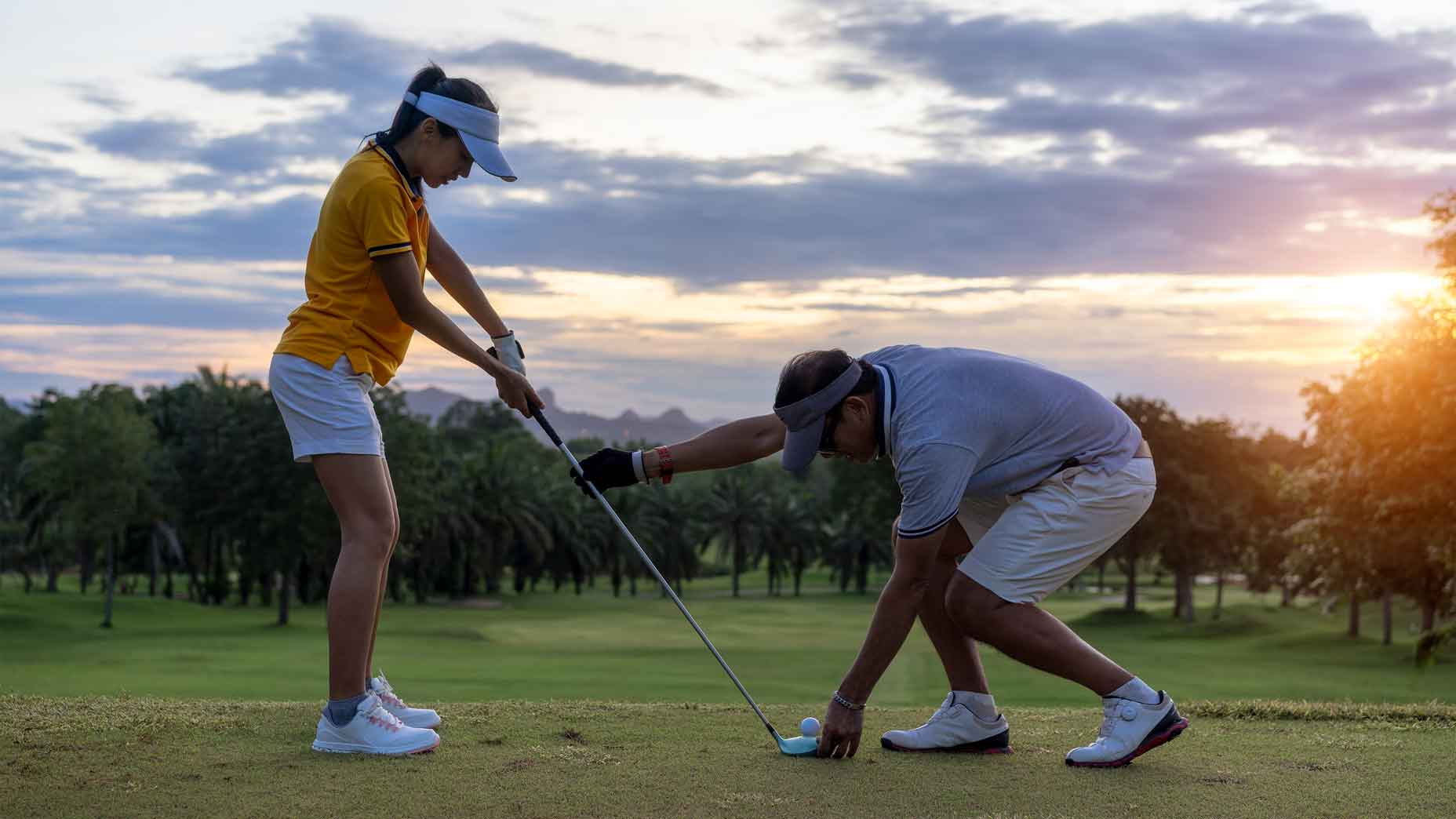
Hitting the driver on the heel can often cause a slice and loss of distance. This is often caused by crossing the target line and hitting the driver with the top of the swingpath. To minimize the impact on the heel, change the height of the tee. This will affect the point of impact.
Keep your feet lighter
You should place less weight on the feet when you hit driver on heel. This will help you balance your weight across the entire foot. The heel and the ball at the address are usually where the weight is balanced. Adjust the weight distribution if your toes are heavier than your heel at the address.
The heel address is a key factor in determining the body's counterbalance. Most pros will place greater weight on the heel of the left at impact. This will cause more rotation. In fact, most pros will place so much weight on the left heel that the front part of the left foot rolls back at impact.

More weight on the left
One of the most common mistakes made by amateur golfers is placing more weight on the left side of the body when hitting the driver on the heel. Your body weight should be evenly distributed to ensure a solid shot. Good launch conditions are also important. You should align your inside heel with the ball for optimal launch conditions. You should also keep your spine straight away from the target. Amateur golfers often lean their upper bodies towards the target in order to keep their balance. This mistake is called the reverse pivot and can be a major cause of less-than-solid shots.
Extreme golf swing
A golf swing that is too aggressive can be described as the club moving in a circle around the hitting area. This can cause the ball to fade or slice and make it difficult to control its flight. To reduce the impact angle, it is a good idea to adjust your timing and grip in case you have an extreme swing.
Sometimes, it can be hard to repeat an over-the top swing. They result in a steep path into the ball and a slice or hook. You can have a lot trouble if you play too much golf.
You can reduce the impact location by changing your tee's height
Your ball flight and launch will be affected by the height of your driver's tee. The ideal tee height places the ball at the equator. This will give the ball a better launch, spin, and distance. To reduce impact location, you can adjust the tee to match the location of your driver.

Teeing the ball is common in golf, but it is important to understand that tee height has a big impact on your ball flight. The height of your tee will affect the ball's spin. So hitting the ball on the heels will slow down its speed. You can increase the distance you are able to reach and your accuracy by increasing the height of your driver's tee.
Fixing a high toe strike
First, adjust your body's balance to the ball. If you feel that your foot is too far out, your body will compensate and the ball will drop to your heel. At address, your arches should have the correct weight.
One way to fix your high toe strike during driver's heel contact is to raise your head slightly. This will keep your driver from hitting you on your heel. It is important that you don't raise your arms above your shoulders when swinging.
FAQ
What's the best time to golf?
Playing golf between May-September is the best time. There is rarely any rain during this period and the temperatures are usually moderate.
The winter months can bring on extreme cold. Also, the snowfall makes it hard to walk the fairways.
Spring and autumn can be difficult because the grass grows too high.
How can I practice my golf swing properly?
Practice makes perfect! Every sport requires practice. You have to practice if your goal is to improve your ability to play golf. You must practice until your swing is mastered.
Practice using both hands. You should start with the shortest shots. Then you can move on to longer drives. Finally, practice chipping and putting.
How do I learn to play golf?
Learning to play golf requires practice and patience. It is possible to improve your game with practice. Here are some tips for you to improve your game.
-
You should practice regularly. Golf requires constant attention and concentration. You won't improve your golf skills if you don’t practice enough.
-
Play with people who play. Playing with people can help you create your own style.
-
Before you start playing, make sure to read up on golf. This will give you an idea of what you need to work on.
-
Don't try to master everything all at once. Begin by focusing your attention on one aspect. One example is to work on your putting and chipping skills. This will help you feel more confident about your game.
-
Take lessons. Take lessons to learn how to position yourself, swing speed, posture, and many other important aspects.
-
Try new techniques. Explore new grips, stances, swings and so forth.
-
Keep records. Record your scores and keep track of your progress. You will be able to identify your areas of improvement.
-
Join a local Golf Club. Many clubs offer lessons at no cost. Many clubs offer free lessons and have helpful members who are willing to help newcomers.
-
Look for a coach. A coach can offer guidance in certain areas.
What type of clubs should you use?
There are many different types of clubs. Most players start out with a driver - a heavy metal club that allows them to hit the ball further. Other clubs include putters, irons wedges, wedges, woods, and irons.
Woods are longer clubs made to allow players to play closer to the pin and still be able to reach green. They are commonly used for long drives, approaches, and even putting.
Irons are shorter clubs that are designed to help players hit the ball closer to the pin. These clubs are used often for chipping and putting, as well as short-distance shots.
Wedges are specialized clubs that are used to control the flight path of the ball. These clubs are often used for precise shots.
Putters are small clubs used to move the ball towards the cup. These are short putts that players use to play.
The type you make depends on the type club you use. Different types of shots work better in different clubs.
Drivers can help you hit the ball further than expected. Wooden are great for driving the ball over long distances. Irons are great for making short shots. Wedges are excellent at controlling the flight of the ball. The perfect tool for rolling the ball in the hole is the putter.
What is a "par"?
Par refers to how many strokes are required to complete a hole. The total score is calculated by adding up each player's individual score.
In a round, there are 18 holes. Each hole gets its own rating. The highest rated hole is called "par 3''. It is located three strokes from hole. "Par 5" is the lowest rated hole. It is only five strokes away from the hole.
How much does a round cost for golf?
Expect to pay $15-$30 per head This price includes greens fees, cart rental and refreshments.
Statistics
- Professional golfers typically make between 60% and 70% of greens in regulation. (en.wikipedia.org)
- They do this by means of assessing and rating courses according to the average good score of a "bogey golfer," a player with a handicap of around 20. (en.wikipedia.org)
- Professional golfers typically make between 60% and 70% of greens in regulation. (en.wikipedia.org)
- In the United States, women made up 25 percent of golfers in 2021, which was up from 19 percent in 2011, and junior female golfers account for 35 percent or 1.1 million golfers.[50] (en.wikipedia.org)
External Links
How To
How to Make a Perfect Swing in Golf
A golfer who is a good player must have a strong understanding about how to play and what he should do to improve. He must know how to use different grips, stances as well as swings and techniques.
These tips can help you to master golf.
-
Learn the basics first - You have to understand the basic rules of golf before you start practicing your swing.
-
Practice makes perfect. - You can practice by going out in nature or indoors and hitting balls at a target. This will allow you to receive feedback on both your form as well as your technique, without having to hurt yourself. After you feel comfortable with your swing mechanics, start playing some golf.
-
Make sure you're ready - Before hitting any ball, check your grip, stance, posture, alignment, club choice, and the distance to the target. If you don't feel right, adjust!
-
Keep it simple. They have perfected the art of their craft through years of practice.
-
Technology is key to improving your golf game. There are many apps available today that can help you analyze your swing, track your score, measure distances, and even give you advice based on your statistics.
-
Be consistent – When practicing, keep these principles in mind. * Only work on one aspect of your game at the time. If you are working on your short game, focus only on the drills. Do not mix up your long game drills with short game drills.
-
One part of your body should be your focus. For instance, if you're working hard on your left arm, then forget about your right arm. It won't improve your overall game.
-
Always be honest - Never cheat yourself by lying to yourself. In other words, if you think you're doing better than you really are, you're cheating yourself.
-
Play with friends--Playing with others will inspire you to improve. In addition to helping you stay motivated and giving you friendly competition, it also helps you keep your mind open.
-
Know your strengths and weak points - Discover where you excel and where there is room for improvement.
-
Have fun. Enjoy the learning process of golf. There is no such thing "perfect" at any skill. You'll enjoy the journey even if you don't achieve perfection.